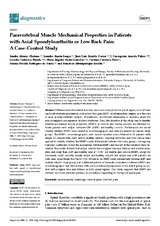Mostrar el registro sencillo del ítem
Paravertebral Muscle Mechanical Properties in Patients with Axial Spondyloarthritis or Low Back Pain: A Case-Control Study
| dc.contributor.author | Alcaraz-Clariana, Sandra | |
| dc.contributor.author | García-Luque, Lourdes | |
| dc.contributor.author | Garrido Castro, Juan Luis | |
| dc.contributor.author | Aranda-Valera, I. Concepción | |
| dc.contributor.author | Ladehesa-Pineda, Lourdes | |
| dc.contributor.author | Puche-Larrubia, María Ángeles | |
| dc.contributor.author | Carmona-Pérez, Cristina | |
| dc.contributor.author | Rodrigues-de-Souza, Daiana Priscila | |
| dc.contributor.author | Alburquerque Sendín, Francisco | |
| dc.date.accessioned | 2021-10-15T07:59:08Z | |
| dc.date.available | 2021-10-15T07:59:08Z | |
| dc.date.issued | 2021 | |
| dc.identifier.uri | http://hdl.handle.net/10396/21886 | |
| dc.description.abstract | Different musculoskeletal disorders are a source of pain in the spinal region; most of them can be divided into mechanical, such as low back pain (LBP), or inflammatory origins, as is the case of axial spondyloarthritis (axSpA). Nevertheless, insufficient information is available about the muscle negative consequences of these conditions. Thus, the objective of this study was to identify whether mechanical muscle properties (MMPs) of cervical and lumbar muscles are different between patients with axSpA, subacute LBP (sLBP), and healthy controls. Furthermore, we aimed identify whether MMPs were related to sociodemographic and clinical variables in various study groups. The MMPs, sociodemographic, and clinical variables were obtained in 43 patients with axSpA, 43 subjects with sLBP, and 43 healthy controls. One-way ANOVAs and ROC curves were applied to identify whether the MMPs could differentiate between the study groups. Intra-group Pearson r coefficients to test the associations between MMPs and the rest of the variables were calculated. The results showed that axSpA subjects have a higher tone and stiffness and a lower relaxation and creep than sLBP and healthy ones (p < 0.05). All lumbar and cervical MMPs, except for decrement, could correctly classify axSpA and healthy subjects and axSpA and sLBP patients (in both cases, Area Under the Curve > 0.8). However, no MMP could differentiate between sLBP and healthy subjects. Each group had a different pattern of bivariate correlations between MMPs and sociodemographic and clinical data, with a worse state and progression of the axSpA group associated with a higher tone and stiffness in both spinal regions. This study supports that MMPs are different and show different patterns of correlations depending on the type of spinal pain. | es_ES |
| dc.format.mimetype | application/pdf | es_ES |
| dc.language.iso | eng | es_ES |
| dc.publisher | MDPI | es_ES |
| dc.rights | https://creativecommons.org/licenses/by/4.0/ | es_ES |
| dc.source | Diagnostics 11(10), 1898 (2021) | es_ES |
| dc.subject | Myotonometry | es_ES |
| dc.subject | Metrology | es_ES |
| dc.subject | Cervical spine | es_ES |
| dc.subject | Low back pain | es_ES |
| dc.title | Paravertebral Muscle Mechanical Properties in Patients with Axial Spondyloarthritis or Low Back Pain: A Case-Control Study | es_ES |
| dc.type | info:eu-repo/semantics/article | es_ES |
| dc.relation.publisherversion | https://doi.org/10.3390/diagnostics11101898 | es_ES |
| dc.rights.accessRights | info:eu-repo/semantics/openAccess | es_ES |

